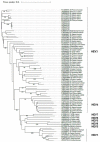Clustered Cases of Waterborne Hepatitis E Virus Infection, France
- PMID: 37243235
- PMCID: PMC10224386
- DOI: 10.3390/v15051149
Clustered Cases of Waterborne Hepatitis E Virus Infection, France
Abstract
The identification of seven cases of hepatitis E virus infection in a French rural hamlet in April 2015 led to investigations confirming the clustering and identifying the source of the infection. Laboratories and general practitioners in the area actively searched for other cases based on RT-PCR and serological tests. The environment, including water sources, was also checked for HEV RNA. Phylogenetic analyses were performed to compare HEV sequences. No other cases were found. Six of the seven patients lived in the same hamlet, and the seventh used to visit his family who lived there. All HEV strains were very similar and belonged to the HEV3f subgenotype, confirming the clustering of these cases. All the patients drank water from the public network. A break in the water supply to the hamlet was identified at the time the infection probably occurred; HEV RNA was also detected in a private water source that was connected to the public water network. The water flowing from the taps was quite turbid during the break. The private water supply containing HEV RNA was the likely source of the contamination. Private water supplies not disconnected from the public network are still frequent in rural areas, where they may contribute to public water pollution.
Keywords: clustered cases; drinking water; hepatitis E virus; waterborne infection.
Conflict of interest statement
The authors declare no conflict of interest.
Figures


References
Publication types
MeSH terms
Substances
LinkOut - more resources
Full Text Sources
Miscellaneous

